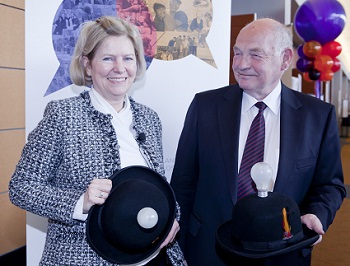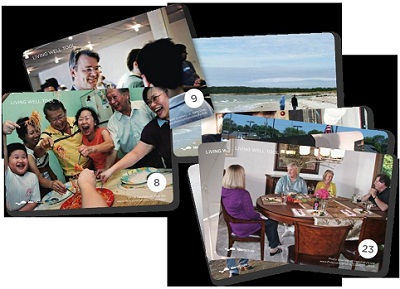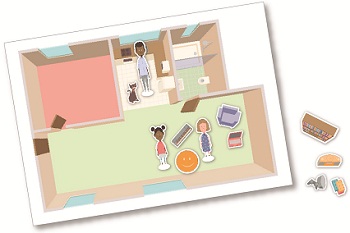Interview with Lise Lotte Bundesen, Managing Director, Ida Institute
CAROLYN SMAKA: Lise Lotte, great to see you again. What's new at the Ida Institute?
LISE LOTTE BUNDESEN: We've just launched Ideas, Speak Up for Action and Awareness for Hearing Loss, our online global competition for ideas that have the potential to generate better understanding of hearing loss, change public perception and encourage people to take action. The Oticon Foundation has awarded a grant to the Ida Institute to facilitate this worldwide open call for ideas.
Lise Lotte Bundesen (left) and Niels Boserup, Chairman of the Oticon Foundation at the launch event for the Ideas Campaign at AudiologyNOW! in Boston, April 2012.
From the beginning, we have been quite aware of the fact that public awareness of hearing loss is not very high. It is also clear that over time there have been a number of public awareness initiatives that, for some reason, haven't been successful in capturing the attention of the media or the general public.
SMAKA: You find this same trend globally, correct?
BUNDESEN: Yes. Hearing loss definitely does not catch the interest of the media. We have tried to talk to both news and entertainment media and we are usually told that hearing loss is not really a sexy topic. That's been one of the things that is surprising to me, because if you talk to people privately, most people have an uncle or a father-in-law, parent or friend who has hearing loss. In private conversations, it comes out quite often, but if you look in the media, hearing loss is not a topic that is talked about. That also seems to be a general trend all over the world, which is intriguing.
So at the Ida Institute, we said, "Okay, we would like to do something about this, but how do we go about it? Other people have attempted to do it before us, so what could we do now?" That's when we started to think about the way we approach challenges at Ida. We have been very successful using a collaborative approach. When we develop a new tool, we always work with a number of people in a collaborative fashion. In that way, we have been able to develop tools, methods and activities that we would not have been able to come up with on our own. We are fortunate to have a large MyIda network that has grown significantly over the past four years. Our MyIda members are very happy to be part of our various collaborative initiatives.
We wanted to see how we could apply some of our previous successes to the public awareness platform. Nobody alone has the answer. That is one of our guiding principles. We know that we alone do not have all the answers but we can have an idea and we can talk to people about it. And that's exactly what we are doing with the Ideas competition. We are asking everybody who wants to participate, "What would it take to raise awareness for hearing loss where you live?"
SMAKA: What does "raise awareness" mean? How do you measure that?
BUNDESEN: The top 10 ideas will be chosen by a selection committee appointed by the Ida Institute. The selection committee will use the following criteria to identify good ideas: ideas that have heart - that inspire us to action and are creative and unique;ideas that are smart - that use the brain and are simple, cost-effective, mind-changing and address real needs;and ideas that have their feet on the ground - that are do-able, relevant locally and globally and have realistic timeframes. Public voting on the website will also play an important role when choosing the best ideas.
As I said before, hearing loss is not something that is ever talked about in the public domain, so if we can come up with just one idea that is compelling, we could really make an impact. I'll give you an example.
Yesterday I was speaking with a gentleman and I asked him, "Think about the life that you lead. What circles do you move in where you could help create more awareness of hearing loss?" He thought about it and said, "Well, I like to bike. I'm just thinking that if you ride a bike and you have problems with your hearing you can endanger yourself. So I think I'm going to call the Bikers´ Union in Denmark and tell them, 'How about doing a little something about this?'" I responded, "I would never in a million years have thought about that!"
SMAKA: Yes, and if you're thinking of it as this big, giant thing, you're missing a small local action that could start a wave from a grassroots perspective.
BUNDESEN: That's the thing. If one person calls the Danish Bikers´ Union, other people can call bikers´ unions in another country about the same thing. That's why we are thinking that the Ideas competition has the possibility of being able to change things. If you think about the little ideas, whether you are in a sports club or a book club, all those places where you live your life, there is a possibility of changing something and raising awareness. All of those little initiatives can create positive change. That said, we are also open for large scale BIG global ideas so basically every idea is welcome.
SMAKA: If someone reading this interview says, "I have some great ideas," how do they enter?
BUNDESEN: They can go to our website, awarenessforhearingloss.com, sign up and submit an idea. That idea, again, can be big or small. It can be two sentences or ten pages. It could even be a video. Whatever people would like to suggest is great. Individuals or groups can submit an idea and there is no cost to participate.
SMAKA: And for how long will you accept these submissions?
BUNDESEN: Through September 2012. So there's plenty of time to think. We launched the competition last night, and already there are about ten ideas posted on awarenessforhearingloss.com. People have ideas. We want to hear them.
SMAKA: What happens after September?
BUNDESEN: Through September, people will be able to go on to the website and comment, debate and vote for their favorite ideas. After September, ten top ideas will be selected. Because the ideas can be on such different levels, small or big, we will spend some time leveling them. If an idea is only two sentences but we think it's a great idea, we'll have business consultants to help make it into a viable plan so that by the end of that phase, we will have ten comparable ideas. Then we will have a VIP panel select the three winning ideas. The representatives for the three winning ideas will be invited to Anaheim for the 2013 AudiologyNOW! conference. The winners will be invited to California for a three-night stay. We are hoping that everybody will join in. It will be exciting to see how this will change things, and I believe it really will.
SMAKA: To switch gears, tell me about the latest tools you've developed.
BUNDESEN: We have two new tools. First is Living Well with Hearing Loss. This tool was developed from our seminar series, Living Well with Hearing Loss. It's a tool that enables hearing care professionals to bring the patient's perspective on his or her daily experience with hearing loss into the clinical setting.
When an audiologist talks to a patient, it can sometimes be difficult to find out what the patient's life is like. Getting that conversation started can be difficult. This tool contains a pack of different pictures that the hearing care professional can give to patients. Patients pick the four to six pictures that reflect situations that they tend to find themselves in. The audiologist now has the opening to ask patients why they picked the pictures they did and what those pictures represent. They also indicate which situations they find easy and which situations are less easy.
Next step is to prioritize each of the situations they chose. How important is each one in their daily life? The final step is then to discuss technical solutions and communication strategies. Clinicians can then reinforce effective communication strategies and begin to explore alternate strategies for difficult situations.
This patient-centered approach allows patient and audiologist to jointly decide on new strategies to implement, set goals for improved communication and formulate a plan for achieving those goals.
SMAKA: Excellent. I would think that the more you do this with patients you are going to learn solutions from the patients who say, "Well, when I do this, then I do this to make it better."
BUNDESEN: Yes, I think so. The tool might look quite complex at first, but we find that the first time clinicians unpack it and get started, the information that they are able to get and the ways they are able to help the patient make this a very worthwhile tool.
SMAKA: To me, it doesn't seem overly complex. It seems intuitive. Seeing the pictures would elicit things from the patient that a question without the prompts would not.
Examples of a few of the pictures from the Living Well tool from Ida Institute.
BUNDESEN: As we were developing the Living Well tool, I conducted a session for patients with only the pack of pictures. What was interesting was that basically any picture was capable of prompting them to speak about what was at the top of their minds and that came through, regardless of the picture.
SMAKA: I heard someone ask this question and I thought it was a good one: when will it be available digitally? Clinicians may want to use it on their computer or on a tablet, right?
BUNDESEN: Yes, we are definitely thinking about a digital version. Right now you can download the Living Well tool for free from idainstitute.com. But the downloaded tool is not interactive. In general, Ida tools are freely shared at no cost. The Living Well tool is not an inexpensive tool to produce in a finished format. For that reason, it is the first Ida tool that we are required to charge a small fee to cover our production costs.
SMAKA: How did the pediatric tool come about?
BUNDESEN: We had a number of pediatric audiologists say to us, "You have all of these great tools, but why don't you make something for pediatrics?" And we thought, "That's a good idea, but we don't know anything about pediatrics." So we put together a focus group and invited 12 pediatric audiologists to come to Denmark to evaluate the current Ida tools and convert them into tools for children. This task force worked and converted the tools into something very different.
My World - Understanding Hearing Loss from the Child's Perspective uses a child-friendly format to allow the hearing care professional and child to explore together how hearing loss affects the child in daily life and to collaborate on formulating effective goals and strategies that could result in better communication. It engages the child, the parents and the audiologist in a shared decision-making process.
This tool is about giving children a voice. Typically, when parents come in for a consultation, parents talk on behalf of their children. The children don't talk themselves, so the parent will say, "Peter does this and Peter says this." Instead, the My World tool uses four picture boards to elicit the child's responses and perspectives. For example, on one side of the board, there are pictures of a playground, house, road, et cetera. On the other side there is a large picture of a home or a classroom. By playing with the elements and re-creating scenes from their own lives, children can discuss successes and challenges related to communication and identify which situations are important to them.
One of the picture boards from the pediatric My World tool from the Ida Institute.
Let's use the classroom as an example. The children get to pick out a figure that represents them. Then, there are all kinds of items to put in to the classroom such as desks and tables. Then you can ask the child Where do you sit? Where does the teacher sit? Where does your best friend sit? Where does the bully sit?" to elicit responses and conversation. This process continues for all of the situations. You can also ask about when they wear their hearing aids in a given environment.
SMAKA: So is the tool designed to be used during a discovery phase, or can you use it to discuss solutions as well?
BUNDESEN: It's a mixture of both. Clinicians can discover information about the child's use of effective communication, reinforce positive patterns and, together with the child, parent or teacher, formulate a strategy for coping with communication issues.
One of the most inspiring aspects to me is that this was an idea that came out of a focus group. The woman leading the group was born with hearing loss. She said she felt so empowered using this tool because she could move the figure representing herself, and she could move the bully. She felt empowered instead of just feeling like an object.
SMAKA: She was able to control the situation, which maybe she couldn't as a child.
BUNDESEN: Exactly, and that was fantastic. She commented that just by saying, "Actually I sit here, and I don't like to sit here - and then move herself," made her feel better.
An instructional video available on idainstitute.com provides a tutorial on using the My World tool in clinical encounters. A listening guide and a documentation form are also available to help hearing care professionals listen actively to what the child is saying and to keep a record of what was discovered and decided during the appointment.
Similar to the Living Well tool, hearing care professionals can learn more about the My World tool, download a free copy for self-assembly or purchase a copy of the finished tool for a nominal fee to cover production costs.
SMAKA: There seemed to be a lot of interest in the tools from the professionals I met at your booth at AudiologyNOW! Thanks so much for your time today. I'll look forward to following up with you in a few months to see how the Speak Up for Action and Awareness of Hearing Loss initiative is developing.
BUNDESEN: Thank you, Carolyn. We're very excited about the initiative and it would be wonderful to speak with you about it again. In the meantime, I hope your readers will submit their ideas at awarenessforhearingloss.com and encourage their colleagues, family and friends to participate.

